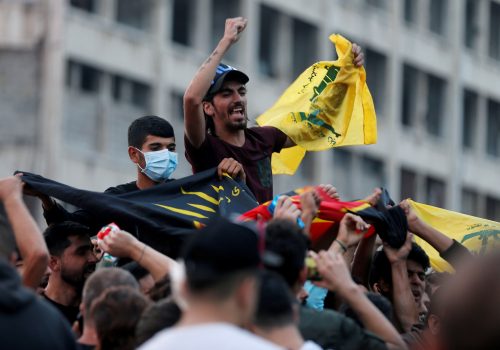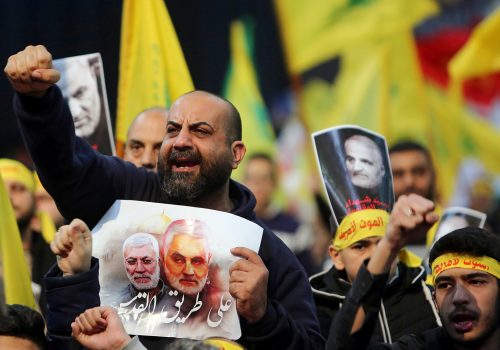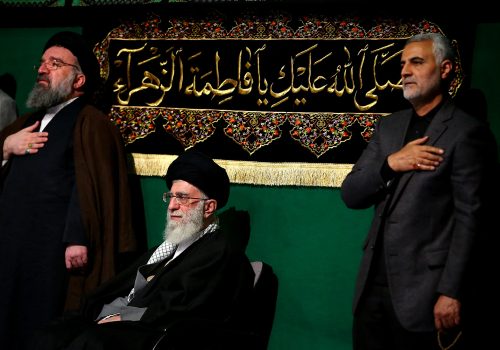Soleimani’s grave isn’t all hearts and roses, like Hezbollah fighters
Before Qasem Soleimani was killed in a US drone strike on January 3, he left very specific instructions over his burial.
In his will, the former leader of the Islamic Revolutionary Guard Corps’ (IRGC) external wing, the Quds Force, requested that his grave bear no “flowery statements,” and that it simply carry the words, “the soldier Qasem Soleimani.” After a period of national mourning, he was buried on January 8, with footage circulating online of earth being dug out to accommodate his body under a flat black gravestone in his home province of Kerman, south-eastern Iran.
Nevertheless, to mark forty days since the Quds Force commander’s assassination, on February 16, his children revealed that his gravestone had been replaced with a slightly more elaborate version. From beneath an Iranian flag, they unveiled a new white stone slab, engraved with red and green tulips, and an epitaph detailing the occupant’s death.
It described Soleimani as a “brave commander of anti-terrorist battles in West Asia” who was “targeted at Baghdad International Airport by the Centcom terrorist unit, and together with a group of his comrades achieved martyrdom.”
Alongside a multitude of television shows, anthems, commemoration events and posters that have emerged to mark Soleimani as a martyr over the weeks since his death, both the relatively plain gravestones show the importance of a solid, non-ephemeral object to reinforce a narrative of both a heroic warrior and humble man.
The aesthetics of Soleimani’s burial site contribute to this. The relative simplicity of both his gravestones—the original and the white replacement—is typical of an IRGC fighter’s final resting place: it is low and unassuming. This custom reflects one interpretation of the prophet Mohammed’s burial site, which was said to be either entirely flat, or in a low humped shape, according to different historical accounts. The military commander’s grave contains the representations of the Islamic martyr—the red colored engravings and the slab itself, like a martyr’s body, is considered humble, pure and untainted.
The role of Soleimani’s burial site in forming his posthumous identity is not unique: epitaphs and gravestones the world over reflect who the deceased was in life. But it does reinforce the significance of mourning and martyrdom in Shia Islam. Shias have “contributed more than any other single group in Islam towards martyrology [histories of martyrs’ lives and sufferings]” according to historian David Cook. In turn, the Iranian state and its proxy networks present themselves as protectors of Shi’ism. While most graves in Iran are also low and modest, the image portrayed in Soleimani’s grave and epitaph reflects the wider message promulgated by the “Axis of Resistance”—the anti-US alliance of Iran, Iraq, Syria and Lebanese Hezbollah—that its fighters are modest, self-effacing, and ready to make sacrifices, up to and including their own lives.
On the other hand, the malignancy of the political project that ultimately ended in Soleimani’s death should not be overlooked. The top military chief was a US-designated terrorist who oversaw a powerful constellation of militant groups across the Middle East. He was ultimately responsible for the killing of thousands of troops and civilians who crossed the path of his networks in Syria, Iraq and Lebanon. His building of militant groups, and role in crushing civil protest, mean that many in the Middle East aren’t sad to see him go. They don’t see in him a humble martyr, but a ruthless leader.
Islamic law doesn’t clearly specify a design for the grave of a martyr, who can be loosely defined as someone “with pure intentions” killed in battle—plague victims have also traditionally been awarded martyrdom status. But, with some modifications, the typical form of the IRGC martyr’s grave has been transferred to its proxies, such as Hezbollah in Lebanon.
The standard Hezbollah fighter’s grave comprises a horizontal marble slab and a vertical headboard bearing the man’s face. Engravings typically include his full name, nom de guerre, birth and death dates, and a description saying that he was “martyred in the course of his jihadi duty.” Added to this are the words, “the Martyr’s Foundation”—Hezbollah’s association that pays for the funeral, burial and grave—and “the Islamic Resistance,” which is how Hezbollah’s supporters often refer to the group. In rural areas, the headboard is sometimes replaced with a shadow box containing the deceased’s belongings—his Quran and prayer beads, for example.
Some fighters are buried in designated martyrs’ cemeteries, including the Garden of the Two Martyrs in Beirut’s southern suburbs, and the nearby Garden of Lady Zeinab, which mostly houses graves of combatants killed in Syria—where Hezbollah is fighting on the side of the Bashar al-Assad regime. Like Soleimani’s resting place, the fighters’ physical gravestones perpetuate the narrative of their dying in combat as “martyrs,” carrying out their “duty of jihad.” Those fighters killed in Syria show the occupant’s face superimposed onto a picture of the Sayeda Zeinab shrine in Damascus. Protecting this Shia pilgrimage site was one of the reasons Hezbollah publicly gave for entering the Syrian conflict in 2013. Some of the graves also feature pictures of Iran’s Supreme Leader Ayatollah Ali Khamenei, whose ideology Hezbollah adheres to. In this way, the group builds religious justification for its military activities into permanent community spaces: the graveyards are busy spots, hosting commemoration events for individual fighters as well as a steady stream of visitors.
But there are differences between Soleimani’s relatively simple grave, and the way that some fighters’ resting places are treated and decorated by their friends and family. This is particularly the case for Hezbollah fighters killed relatively recently in Syria. While the group was closely tied to Soleimani, its fighters’ exuberantly-decorated graves are a world away from his sober resting place.

The graves explode with lights, color and elaborate floral decorations, cut-out models of men toting assault rifles, glitter, and pictures in heart-shaped frames. Some are covered with plastic sheeting, hiding the plain marble grave, with superimposed images of Hezbollah logos, dog tags, and men in military garb. Surrounding the graves are plant pots, astroturf, and illuminated plastic trees. It makes the Garden cemetery feel just as such.
“It doesn’t change anything, but because he is a martyr we think he is holy, so we prefer that he has a special grave, that it’s really well done-up,” said a former Hezbollah military trainer, of the elaborate grave decorations. “Maybe his family wanted to say, that he gave them a lot, but they didn’t give [as much], so they decorate his grave to relieve their conscience.”
The graves also appear designed to reflect the social status afforded to a martyr. They are mini shrines to men whose friends and family believe to be “alive with their Lord”—the Quran dictates that a martyr is not really dead, but is living a new life of bounty.
“With normal people, it’s God who takes them when they die, but the martyr dies voluntarily, and this is why his standing is higher than others,” said a Hezbollah fighter who served in Syria. “As soon as he is martyred, on his birthday, and on Shia religious festivals, his comrades and children—if he had them—decorate his grave.”
These are graves where piety, personal devotion, and economics mix: the grave is paid for by Hezbollah but the extra decorations are added at friends’ and families’ own expense, according to multiple sources close to Hezbollah, who described practices around the resting places.
The widow of a Hezbollah fighter killed in the 1990s confirmed that extra decorations—incense and a rose on Islamic holidays, for example—came at her expense. She was disdainful of overly-elaborate adornments: “It is haram[forbidden], it is waste of money,” she said. “It is much better to give the money to poor people.”
Will Qasem Soleimani’s relatively simple grave—reinforcing a narrative of his humble nature—induce a new trend for more sober resting places among IRGC-linked fighters? It’s hard to tell at the moment. Nevertheless, while Hezbollah combatants looked up to the commander in life, their graves take on highly-personalized and vibrant forms that veer away from his modest grave site. The hearts and glitter don’t appear to be going anywhere yet.
Lizzie Porter is a freelance journalist based in Beirut, Lebanon, focusing on Shia politics and religion, Lebanon, Syria and Iraq. Follow her on Twitter: @lcmporter.
Translation by Deeba Shadnia and Ghaith Alhallak
Image: Hezbollah fighters' graves at the Garden of Lady Zeinab cemetery, which is reserved for combatants, in Beirut's southern suburbs


